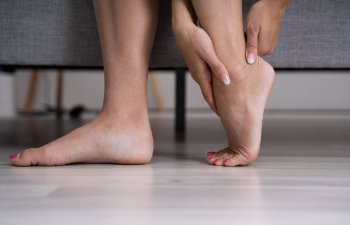Is My Heel Pain Caused By Bone Spurs?

Heel pain can make every step a challenge—whether you’re walking to the subway, standing at work, or enjoying a workout in Central Park. One possible cause is heel bone spurs—bony growths that develop on the heel bone (calcaneus) and can cause discomfort, especially during weight-bearing activities.
At the Manhattan office of Stuart J. Mogul, DPM, FACFAS, we regularly diagnose and treat patients with bone spurs, helping them find relief and get back to an active lifestyle.
How Do Heel Bone Spurs Form?
A heel spur is a small, pointed bony outgrowth that develops due to calcium deposits building up over time on the heel bone. This process can take months or even years.
The most common trigger is repetitive stress on the foot ligaments and muscles, which can lead to microtears in the membrane covering the heel bone. Your body responds by depositing calcium to protect the area—eventually forming a spur.
Risk factors include:
- Repetitive high-impact activities (running, dancing, jumping)
- Wearing unsupportive or worn-out footwear
- Excess body weight which increases stress on the heel
- Flat feet or high arches that alter walking mechanics
- Age—heel spurs are more common after age 40
Types of Heel Bone Spurs
There are several types of bony growths that can occur around the heel:
- Plantar Heel Spur – Develops on the bottom of the heel bone, often linked with plantar fasciitis. This is the most common type and can measure up to half an inch in length.
- Posterior Heel Spur – Forms at the back of the heel bone, near the Achilles tendon insertion. Often associated with Haglund’s deformity or chronic Achilles tendon irritation.
- Inferior Calcaneal Spur – Another term for a plantar spur, but sometimes used to describe smaller bony protrusions that don’t extend as far.
- Dorsal Heel Spur – Less common, located on the top surface of the heel bone.
Symptoms of Heel Spurs
Interestingly, not all heel spurs cause pain—according to the American Academy of Orthopaedic Surgeons, only about 50% of people with a heel spur experience symptoms. When pain does occur, it’s often due to associated soft tissue inflammation rather than the spur itself.
Symptoms may include:
- Sharp pain in the heel when standing up after rest (“first-step pain”)
- A dull ache in the heel throughout the day
- Tenderness, swelling, or warmth around the heel
- Discomfort during exercise, especially running or walking uphill
- Difficulty walking barefoot on hard surfaces
Treatment Options for Heel Bone Spurs
At Dr. Mogul’s NYC practice, treatment begins with a comprehensive evaluation, often including X-rays to confirm the presence and location of the spur.
Non-surgical treatments typically help the majority of patients:
- Rest and activity modification to reduce repetitive heel stress
- Custom orthotics to correct biomechanics and reduce pressure
- Supportive footwear with cushioning and shock absorption
- Physical therapy to stretch and strengthen foot muscles
- Anti-inflammatory medications or corticosteroid injections for pain relief
- Night splints to maintain optimal foot positioning during sleep
If conservative care does not provide relief after several months, surgical options may be considered. Heel spur removal surgery involves excising the bony growth and, if necessary, addressing any underlying plantar fascia or Achilles tendon issues.
When to See a Specialist
If your heel pain persists for more than a week despite rest and supportive footwear—or if it interferes with your daily activities—it’s time for a professional evaluation. Left untreated, heel spurs and their underlying causes can worsen, leading to chronic pain or changes in gait that may affect other joints.
Dr. Stuart J. Mogul, DPM, FACFAS, offers expert diagnosis and advanced treatment options for heel spurs and other foot conditions right here in Manhattan. His patient-centered approach focuses on accurate diagnosis, effective relief, and prevention of future problems.
If heel pain is slowing you down, call our NYC office today to schedule your consultation. Relief is possible—and the first step starts here.
Posted on behalf of
1111 Park Avenue Suite 1B
New York, NY 10128
Phone: (212) 769-0066
Email: contact@footsurgerycenternyc.com
Monday - Friday 8:30 AM – 6:00 PM
